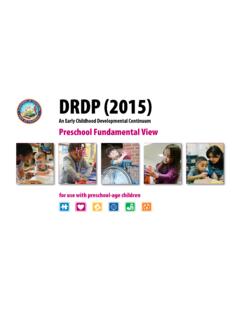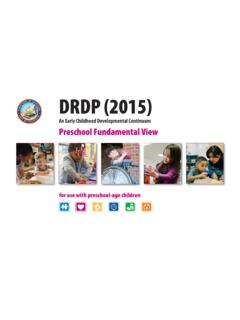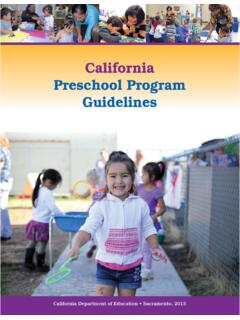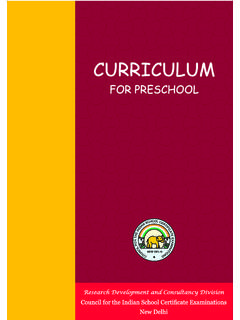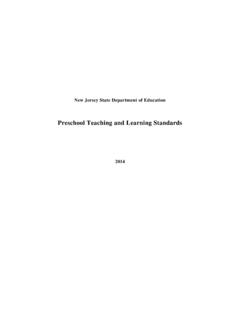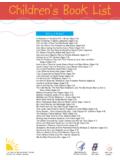Transcription of DRDP (2015): Infant/Toddler Comprehensive View
1 DRDP (2015). An Early Childhood Developmental Continuum Infant/Toddler Comprehensive view for use with infants and toddlers The DRDP (2015) was developed by the California Department of Education, Early Learning and Care Division and Special Education Division, with assistance from: Berkeley Evaluation and Assessment Research Center, University of California, Berkeley Desired Results Access Project, Napa County Ofce of Education Desired Results Developmental Profles (2015) Instrument and Research Studies Project, WestEd's Center for Child and Family Studies Desired Results Training and Technical Assistance Project, WestEd's Center for Child and Family Studies The DRDP (2015) is available at the California Department of Education Website at For more information Early Learning and Care Division Programs may contact: Desired Results Training and Technical Assistance Project Website: Email: Phone.
2 (800) 770-6339. Special Education Division Programs may contact: Desired Results Access Project Website: Email: Phone: (800) 673-9220. 2013 2019 by the California Department of Education All Rights Reserved. Permission to reproduce only for instructional purposes. DRDP (2015). An Early Childhood Developmental Continuum Infant/Toddler Comprehensive view For use with infants and toddlers Table of Contents Introduction to the DRDP (2015) .. Intro-1. Information about Selected Key Features ..Intro-1. Guide to DRDP (2015) Views ..Intro-2. About the Measures of the DRDP (2015) ..Intro-3. The 3 Steps to Completing the DRDP (2015).
3 Intro-6. Step 1: Observation and Documentation ..Intro-6. Step 2: Rating the Measures ..Intro-7. Step 3: Finalize the Assessment ..Intro-9. Early Education Information Page .. Intro-10. Special Education Information Page .. Intro-11. Quick Guide to Rating the Measures .. Intro-12. Rating Record for Use with Infants and Toddlers in Early Care and Education Programs and Special Education Programs .. Intro-13. Summary of Measures .. Intro-14. Measures at-a-Glance .. Intro-15. Measures of the DRDP (2015) .. 1. Developmental Domain: ATL-REG Approaches to Learning Self-Regulation .. 1. ATL-REG 1: Attention Maintenance .. 1.
4 ATL-REG 2: Self-Comforting .. 2. ATL-REG 3: Imitation .. 3. ATL-REG 4: Curiosity and Initiative in Learning .. 4. ATL-REG 5: Self-Control of Feelings and Behavior .. 5. DRDP (2015): An Early Childhood Developmental Continuum Infant/Toddler Comprehensive view June 27, 2019 2013 2019 California Department of Education All rights reserved i Developmental Domain: SED Social and Emotional Development .. 6. SED 1: Identity of Self in Relation to Others .. 6. SED 2: Social and Emotional Understanding .. 7. SED 3: Relationships and Social Interactions with Familiar Adults .. 8. SED 4: Relationships and Social Interactions with Peers.
5 9. SED 5: Symbolic and Sociodramatic Play .. 10. Developmental Domain: LLD Language and Literacy Development .. 11. LLD 1: Understanding of Language (Receptive) .. 11. LLD 2: Responsiveness to Language .. 12. LLD 3: Communication and Use of Language (Expressive) .. 13. LLD 4: Reciprocal Communication and Conversation .. 14. LLD 5: Interest in Literacy .. 15. Developmental Domain: COG Cognition, Including Math and Science .. 16. COG 1: Spatial Relationships .. 16. COG 2: Classifcation .. 17. COG 3: Number Sense of Quantity .. 18. COG 8: Cause and Efect.. 19. COG 9: Inquiry Through Observation and Investigation .. 20. COG 11: Knowledge of the Natural World.
6 21. Developmental Domain: PD-HLTH Physical Development Health.. 22. PD-HLTH 1: Perceptual-Motor Skills and Movement Concepts .. 22. PD-HLTH 2: Gross Locomotor Movement Skills .. 23. PD-HLTH 3: Gross Motor Manipulative Skills .. 24. PD-HLTH 4: Fine Motor Manipulative Skills .. 25. PD-HLTH 5: Safety.. 26. PD-HLTH 6: Personal Care Routines: Hygiene .. 27. PD-HLTH 7: Personal Care Routines: Feeding .. 28. PD-HLTH 8: Personal Care Routines: Dressing .. 29. Glossary of Terms and Phrases Used in the DRDP (2015) .. 30. Appendix A: Requirements of the DRDP (2015) Assessment .. 32. Appendix B: Resources for Assessing Children who are Dual Language Learners with the DRDP (2015).
7 33. Appendix C: Strategies for Observation and Documentation .. 35. Appendix D: Comprehensive Defnitions of Adaptations to be Used with the DRDP (2015).. 37. Appendix E: Resources for Working in Partnership with Families .. 38. Appendix F: Collaboration to Complete the DRDP (2015) .. 40. DRDP (2015): An Early Childhood Developmental Continuum Infant/Toddler Comprehensive view June 27, 2019 2013 2019 California Department of Education All rights reserved ii Introduction to the DRDP (2015) Information about Selected Key Features Welcome to the Desired Results Developmental Profile (2015) [DRDP (2015)]: Three of these key features: (1) consideration of young children who are dual language A Developmental Continuum from Early Infancy to Kindergarten Entry.
8 The DRDP (2015) is a learners, (2) universal design and adaptations for children with IFSPs and IEPs, and (3) a formative assessment instrument developed by the California Department of Education for detailed description of the developmental domains that make up the instrument, are young children and their families used to inform instruction and program development. described in more detail to help teachers and service providers better understand and rate the measures of the DRDP (2015). Young Dual Language Learners and the DRDP (2015). Dual language learners are children learning two or more languages at the same time, as well as those children learning a second language while continuing to develop their first (or home) language.
9 A child's experience with one or more languages is an asset to build on in the early childhood setting. It is critical to consider the child's communication in all the languages that he or she is learning in order to have an accurate picture of a child's knowledge and skills. Young children, including children with disabilities, can successfully learn two or more languages. Learning two or more languages has linguistic, social, cognitive, academic, and cultural benefits. The path to learning one language shares many Key Features of the DRDP (2015): similarities with the path to learning two or more languages. There are also differences that must be taken into consideration when assessing young children who are dual language The DRDP (2015) is administered in natural settings through teacher observations, learners.
10 Children may have vocabulary for concepts in one language and vocabulary family observations, and examples of children's work. Ongoing documentation for other concepts in another language. So it is important to assess children in all of the of children's knowledge and skills in everyday environments is a recommended languages he or she understands and uses. The DRDP (2015) addresses cultural and practice for early childhood assessment. linguistic responsiveness in two primary ways: The DRDP(2015) represents a full continuum of development from early infancy up 1. Teachers and service providers observe and document children's behavior in both to kindergarten entry.



